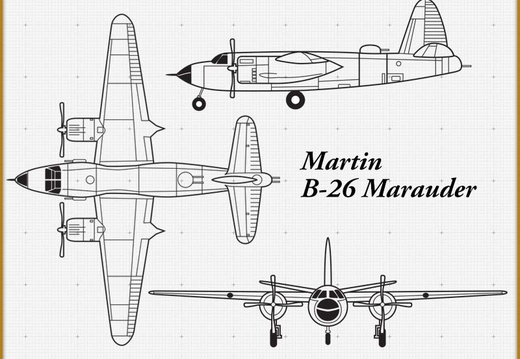
MARTIN B-26 MARAUDER
In 1939 the military contracted with the Glenn Martin Company to design a twin-engine medium powered bomber. The Marauder cruised at 10 to 15,000 feet and had a gun turret on top near the rear of the aircraft. The design was converted quickly converted into a production aircraft, and the first flight was on November 15, 1940. Several months later, in February 1941, the first B-26 was assigned to the 22nd Bomb Group at Langley Field.
The aircraft, initially known as the "widowmaker," suffered many operational problems early on. These problems were corrected and the Marauder became one of the Air Force’s most successful bombers. During World War II the army used the B-26 primarily in Europe and the Mediterranean, but it did see some action in the Pacific. It was used to support ground troops by attacking fortified enemy positions and transportation sites. A number of variants were created during the war. The B-26 was phased out by May 1945.
Utilization at Glenn: The B-26 Marauder was the first aircraft acquired by the NACA's engine research lab in Cleveland. It arrived in January 1943, just as the new lab was beginning to operate on a full-time schedule. NACA researchers were asked to investigate the overheating of the aircraft’s Wright R-2800 engines. One series of tests examined cooling only the engine cylinders that were over-heating, rather than the entire engine. During one test flight the right engine began leaking oil requiring an emergency landing. The pilot managed to get the aircraft back to the hangar where the AERL fire crew doused the engine in CO2. The aircraft left Cleveland in October 1943.
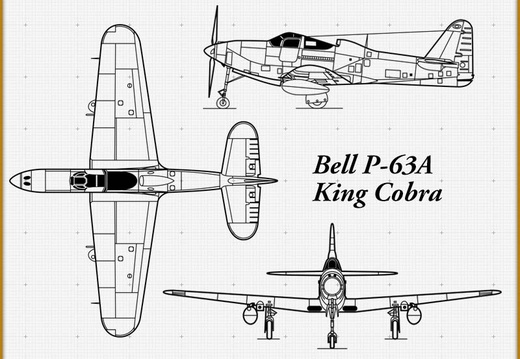
BELL P-63A KING COBRA
The Bell P-63A King Cobra, first produced in 1942, was an improvement on Bell’s P–39. Both of the aircraft used a rear-mounted engine that spun the propeller in the nose. This design permitted the installation of extra weapons at the front end. The aircraft was low-winged and had a tricycle landing gears. The P-63A was slightly longer and had a more angular tail. The P-63A was powered by Allison’s water-cooled V-1710-93 with a supercharger stage.
Persistent performance problems at high altitudes prevented its acceptance by the Air Corps. Instead many of the P–63As were transferred to the Soviet Union for low altitude attack missions. Ensuing design changes were suggested by the Soviets. The US used some King Cobras for pilot training.
Utilization at Glenn: The military provided Lewis with a Bell P–63A King Cobra in October 1943 to complement the lab's extensive efforts to improve the Allison V–1710 engine. Researchers were able to improve the efficiency, capacity and pressure ratio of the engine’s supercharger. They found that improved cooling significantly reduced engine knock in the fuel. Once the researchers were satisfied with their improvements, the new supercharger and cooling components were installed on the P–63A. The Flight Research Division first established the aircraft’s normal flight performance parameters such as speed at various altitudes, rate of climb, and peak altitude. Ensuing flights established the performance parameters of the new configuration in order to determine the improved performance. The program increased V–1710’s horsepower from 1650 to 2250. The aircraft was returned to the military in June 1945.
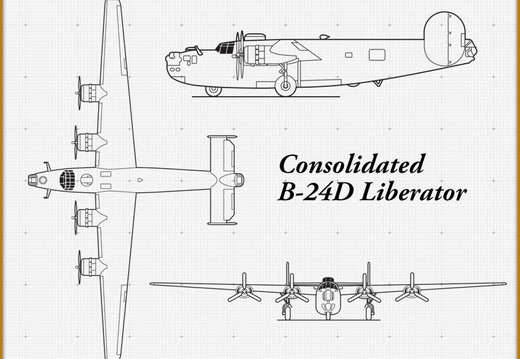
CONSOLIDATED B-24D LIBERATOR
The Consolidated Aircraft Company created the four-engine B-24 Liberator in the early 1940s as an improvement of the Boeing B-17. During World War II the bomber was employed on long-duration bombing missions in both Europe and the Pacific. Though sometimes difficult to fly, the B-24 possessed greater speed, range, and bomb loads than the B-17. The aircraft earned its "The Flying Coffin" nickname because the single exit point was located in the rear of the aircraft, which was difficult to access with parachutes. The US produced greater numbers of the famous B-24 than any other aircraft during the war.
The B-24M variation added windows to the waist gunner’s positions near the rear of the aircraft. Production of the B‒24M version did not begin until October 1944 with the end of the war in Europe approaching. This resulted in scores of unneeded bombers when hostilities ended. This B‒24M arrived at the NACA Lewis laboratory in November 1945.
Utilization at Glenn: The NACA’s B-24M became one of the laboratory’s most frequently used aircraft. Mechanics repeatedly modified the B-24M to study different icing phenomena on components such as windshields, antenna, propellers, and engines. Each component had individual thermal ice protection devices which allowed researchers to determine the effect of ice on specific areas. Over the next nine years researchers studied almost all components, including wings, tail, engine cowls, nose, propellers, and antennas in icing conditions.
They also utilized the B‒24M was to study ice buildup on jet engines. A General Electric I‒16 engine was installed in the aircraft’s waist compartment. An air scoop on the top of the aircraft ducted cold external air to the engine inside. Water spray nozzles inside the aircraft simulated icing conditions at the turbojet’s inlet. Later a Westinghouse 24C turbojet was installed under the B‒24M’s right wing to study its performance as the crew flew the aircraft into hazardous icing conditions. After nearly four years of intensive service at Lewis the NACA transferred the B‒24M in July 1949.
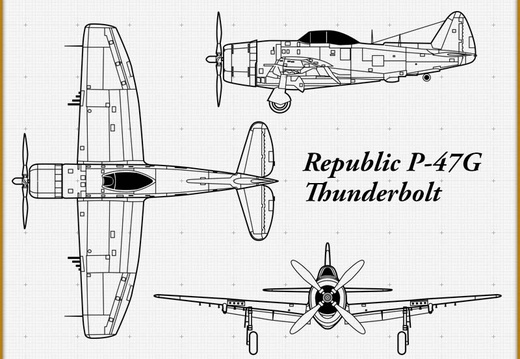
REPUBLIC P-47G THUNDERBOLT
Republic P-47 Thunderbolt was an iconic World War II fighter plane. The first aircraft was delivered to the military in March 1942 and entered combat one year later. The P-47 was a large and heavy single-engine fighter that could withstand severe damage. The heart of the P-47 was its Pratt & Whitney Twin Wasp engine with a complex turbosupercharger system. The P-47 was armed with four guns in each wing and could haul substantial bomb or rocket loads. The US utilized the Thunderbolts in nearly every region of the war as both high-altitude escort fighters and low-altitude bombers.
Over 15,000 Thunderbolt's were produced during the war. To meet the high military demand, the Curtiss-Wright Company began assisting Republic with the manufacturing. The Curtiss models were designated as P-47Gs, but were essentially the same as the Republic P-47D. These models included improved engine cooling flaps, water injection in the engine, and a variety of other minor modifications to the original design.
Utilization at Glenn: The military loaned a P-47G Thunderbolt to the laboratory in March 1943 to test NACA modifications to the Wright R-2800 engine’s cooling system at higher altitudes. Researchers used ground-based tests to map the engine’s normal operating parameters. They then developed an extensive flight test program with the P-47G to study temperature distribution among the engine's 18 cylinders and develop methods to improve that distribution. The P-47G tests successfully demonstrated that the NACA-developed cooling correlation could be used to predict engine cooling at different altitudes. The P-47G was active over Cleveland throughout the war, even after the initial cooling study until October 1944.
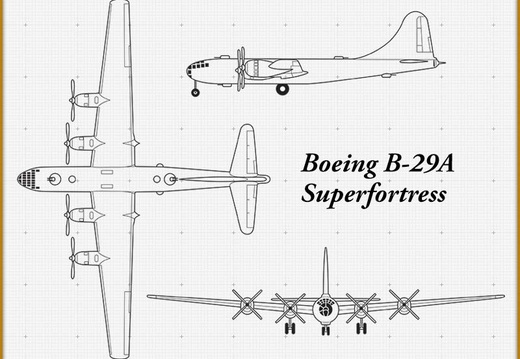
BOEING B-29A SUPERFORTRESS
Boeing developed the B-29 Superfortress as a high-altitude daylight bomber for World War II. Although physically about the same size as its predecessors, the B-17 and B-24, the B-29 was much more refined in design. It had nearly twice the power and weight as the previous bombers, yet it was significantly faster and could reach higher altitudes. Other innovations included a pressurized cabin, fire control system, and remote-controlled machine-gun turrets.
The first B-29s were in the air in 1943, but they suffered a variety of problems, largely stemming from the military’s unprecedented rush to develop the aircraft. The four powerful Wright R-3350 engines posed significant problems during the war particularly at high altitudes. Thus military leaders cancelled the B-29’s high-altitude daytime missions and instituted low-altitude nighttime incendiary bombing missions.
The B-29A model, built exclusively at Boeing's Renton, Washington plant, featured an improved wing design and a four gun forward top turret. Boeing produced 1100 of the B-29A bombers before production stopped in May 1946. The Air Force used the B-29A extensively in the Korean War during the early 1950s, but retired it from combat afterwards.
Utilization at Glenn: The military flew a B-29A to Cleveland on June 22, 1944 to flight test NACA modifications to its Wright R-3350 engines. B-29 pilots had been reporting that their engines were over-heating and losing power at higher altitudes. NACA researchers studied the engines in the lab's Engine Research Building and Altitude Wind Tunnel. New methods of ducting the cooling air flow through the engine and injecting the fuel were developed. These modifications were successfully flight tested multiple times on the B-29A during in June and July 1944.
After the war, another the laboratory acquired another B-29. Between April 1946 and October 1948 it was used as a flying testbed for turbojet and ramjet engines. The engines were mounted under the fuselage and operated in flight conditions. Ramjet-powered missiles were also launched from the aircraft.
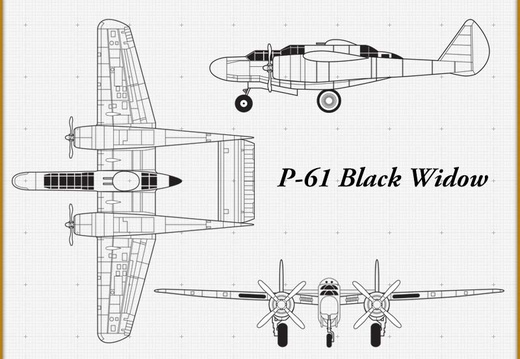
NORTHROP P-61 BLACK WIDOW
The Northrup P-61 Black Widow was developed during World War II specifically for nighttime attacks. Its unique design featured a fuselage that ended before the tail, and each of the twin boom arrangements extended from the engine mounts on the wings to a separate tail. The tails were joined by a single tail plane. The P-61 was designed so the crew could fly and track enemies in complete darkness. It carried a radar system in its nose and was painted black. It was the largest and heaviest U.S. fighter in the war. The P-61 entered the Pacific and European regions of the war in July 1944 and remained in service through 1950.
Utilization at Glenn: After World War II, several Black Widows were used for research. The Navy used them to conduct ejector seat studies. NACA's Ames Aeronautical Laboratory (now NASA's Ames Research Center) performed high-altitude drop tests for its swept-wing research using a Black Widow. NACA's Lewis Flight Propulsion Laboratory (now NASA's Glenn Research Center) used one as a subsonic test bed for ramjet engines and swept-back wing aircraft. Lewis was in the midst of a massive ramjet research effort when it acquired the Black Widow in October 1945. The lab studied ramjets in wind tunnels, altitude tanks, and attached to research aircraft, like the Black Widow. The aircraft accelerated the ramjet until it reached a velocity at which it could be ignited. Sensors and instrumentation fed data from the ramjet to the pilot and to researchers on the ground.
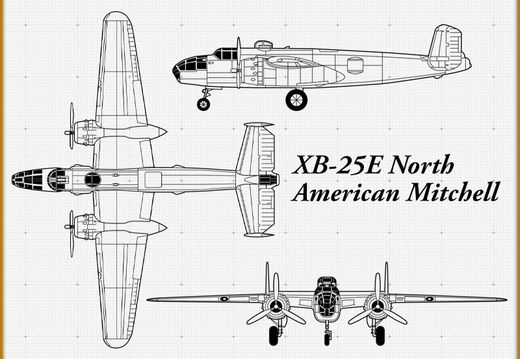
XB-25E NORTH AMERICAN MITCHELL
North American Mitchell began development of the B-25 Mitchell in the mid-1930s as a transport aircraft. The company modified the aircraft in 1939 to serve as a medium-range bomber in 1939. There was such a desperate need for this type of bomber that North American did not build any experimental or prototype versions during the development. Changes to the basic design were incorporated into aircraft on the production line or post-production modification centers. A significant modification was the switch from angled wings to the "gull wing" design to improve stabilization. The military received the first B-25s in February 1941. The US, and several of its allies, used the B-25s in every combat area of the war for mid-level bombing and low-altitude raids. Most famously, General James Doolittle led a B-25 squadron on a daring post-Pearl Harbor retaliatory raid over Tokyo in April 1942.
The B-25C, powered by two Wright R-2600-13 radial engines, was the first mass-produced B-25. It included deicing equipment, a window in the nose, and nose armament. In 1942 a B-26C was modified to flight test deicing and anti-icing equipment. The aircraft, dubbed "the Flamin' Maimie," routed engine exhaust gases to heat exchangers that circulated the hot gas throughout the leading and trailing edges of the wings and tail.
Utilization at Glenn: The Army Air Corps used the unique XB-25E from 1942 to 1944 to test a hot gas anti-icing system. Although the test provided successful, the military decided not to incorporate the system into the other B-25s. On July 10, 1944, the aircraft was transferred to the NACA’s lab in Cleveland and equipped with additional instrumentation and measuring devices. The NACA used the XB-25E exclusively for icing research. Lewis pilots flew the XB-25E into perilous weather conditions all across the country to study both deicing technologies and the physics of ice-producing clouds. These dangerous flights led to advances in weather sensing instruments and flight planning. The NACA transferred the aircraft in February 1953.
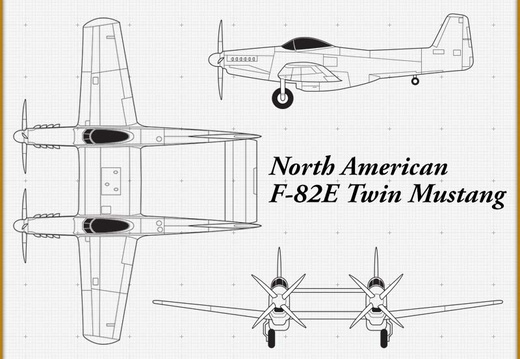
NORTH AMERICAN F-82E TWIN MUSTANG
North American developed its unique F-82 Twin Mustang during the latter portion of World War II so that two pilots could fly long distances between Pacific islands. One of the pilots could be rested and ready for combat when they arrived. Although the Twin Mustang appears to be just two P-51H fighters bonded together on a single wing-span, it was actually an entirely new design. Each of the fuselages was powered by a Packard V-1710 piston engine. The F-82E models were upgraded with Allison liquid-cooled V-1710 piston engines. The Twin Mustang was the final propeller-driven aircraft purchased by the Air Force.
The prototype Twin Mustang first flew in July 1945, but production models were not ready in time for World War II. The vehicle did have a brief, but successful career in the post-war years and in the Korean War as an escort and night fighter. They provided the first aerial victory of the war and shot down over twenty enemy aircraft before being phased out by 1953.
Utilization at Glenn: NACA Lewis possessed three F-82s in the post-War years. The laboratory acquired the first in 1947 for use as a test bed for ramjet engines. The aircraft was damaged in a runway incident in December 1949 and soon transferred. The second arrived in January 1950 and flew high-altitude icing studies. The third, known as Betty Joe, was acquired in September 1950 to carry on the ramjet studies started by the initial F-82.
On February 28, 1947 Betty Joe set a world record for fighters as it flew 4968 miles non-stop from Honolulu to New York City. At Lewis various ramjets or missiles were mounted below the wingspan between the two fuselages for flight testing. It was transferred after suffering wing damage in June 1957 and is currently on display at the USAF Museum in Dayton, Ohio.
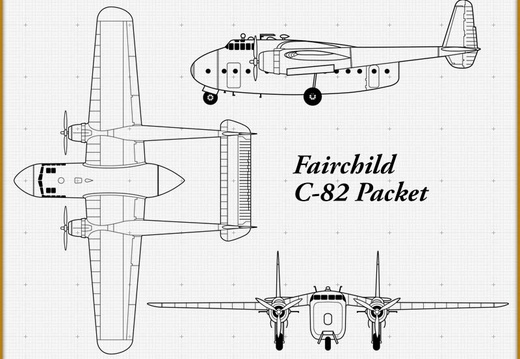
FAIRCHILD C-82 PACKET
The Fairchild C‒82 Packet was a large cargo and troop transport aircraft that entered service in late 1945. Its large low-to-the-ground rear doors allowed the easy loading of vehicles and large equipment. The C-82 could also transport 34 personnel on stretchers. The most well-known application of the C-82 transports occurred during the Berlin airlift in 1948 and 1949. Fairchild ceased production of the Packet in 1948.
Utilization at Glenn: The NACA had a unique role for the C-82 Packets. In response to an escalating number of transport aircraft crashes in the mid-1940s, the NACA researchers undertook a decade-long investigation into a number of issues surrounding low-altitude aircraft crashes. The NACA acquired a number of service-weary aircraft, including several Packets that would be purposely destroyed to study low-altitude aircraft crashes. The researchers sent unpiloted aircraft down the runway until they came into contact with poles which tore open the fuel tanks in the wings and crashed into barriers at the end of the runway. The researchers studied the ensuing fire and developed methods for preventing ignition and improving the structural design of aircraft.
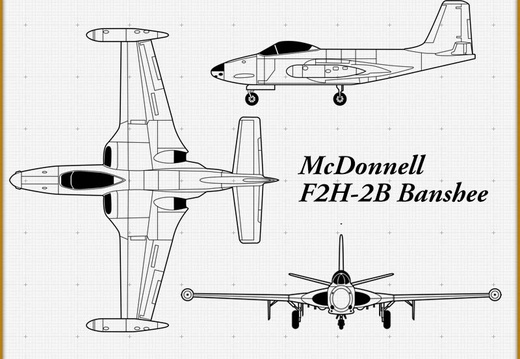
MCDONNELL F2H-2B BANSHEE
The McDonnell F2H-2 Banshee was a carrier-based fighter jet that was used extensively by the Navy during the Korean War. McDonnell based the design on its FH-1 Phantom but added extra armament and a larger fuel tank. The F2H-2B variation included sturdier wings and landing gear to accommodate a heavier weapons payload. The Banshee was powered by two J-34-WE-34 jet engines. The Navy used the Banshees to strike ground targets and provide support to troops. The Banshee’s high performance and the lack of North Korean air power resulted in almost no hostile interactions. The aircraft provided support for the Navy until its retirement in 1959.
Utilization at Glenn: The NACA acquired the F2H-2 Banshee in January 1955 to launch ramjet-powered research missiles and assist with engine noise reduction research. As the introduction of turbojet-powered airliners loomed, there was increasing concern regarding the noise to both the passengers and residences on the ground. Air flow along the fuselage was once source of noise. Researchers used the F2H-2B Banshee in 1955 and 1956 in order to measure the noise coming directly from air flow over surfaces, particularly the wings. The NACA was conducting a series of aircraft-launched missile drops over Wallops Island to study reentry aerodynamics and ramjet engine performance. In July 1958 the Banshee began participating in these flights. The aircraft was transferred in 1959.
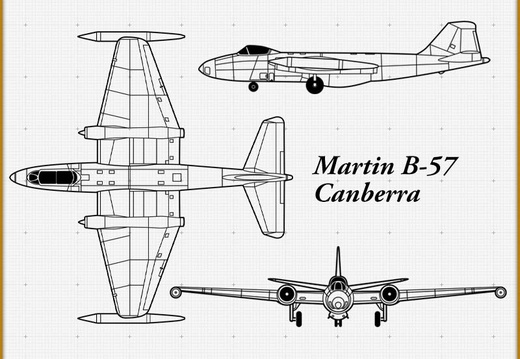
MARTIN B-57 CANBERRA
The recently-reactivated English Electric Company Ltd. Developed the B-57 Canberra in response to a 1944 proposal by the British Ministry of Aircraft Production. The B-57’s first test flight took place in May 1949. At the time the US Air Force needed to replace its Douglas B-26. It selected the Canberra after it set an unofficial time record for crossing the Atlantic in February 1951. The event was also the first unrefueled crossing. The US-based Martin was selected to perform the manufacturing. The initial B57A was slightly redesigned to carry only one pilot and one engineer. It also now incorporated two 7200-pound thrust Armstrong-Siddeley Sapphire engines, which were licensed to Wright Aeronautical and renamed the J65. The B57B, which first flew in June 1954, was an upgraded version of the B-57A that included armament, an improved bomb bay, and placement of the navigator behind the pilot. Over 200 of the B-57Bs were manufactured.
The Air Force’s 58th Weather Reconnaissance Squadron used B-57s in the 1960s to take high-altitude samples of the atmosphere in locations where nuclear testing was suspected. Due to structural damage to the wings the aircraft were largely retired by 1974. NASA’s Johnson Space Center operates the only two operating B-57s in existence today for high-altitude research.
Utilization at Glenn: Lewis initially acquired the B-57B in May 1965 for the groundbreaking Project Bee research. The project sought to prove that the high-energy liquid hydrogen could be used as aircraft fuel. The B-57B was setup to take off and land using traditional fuel, but switched over to the liquid hydrogen while in flight over Lake Erie. The tests were successful and would be a key element in convincing others in NASA that liquid hydrogen was safe to use on the Saturn rocket. In 1966 the B-57A was tied down on the hangar apron as Lewis engineers recorded the decibel and frequency levels of the J-65 engines. After conducting the initial recordings, research followed to construct quieter engines. In the 1960s Lewis established a standardized way to calibrate solar cells using the B-57A aircraft. The pilots would take the aircraft up into the troposphere and open the solar cell to the sunlight. The aircraft would quickly, but steadily descend while instruments recorded how much energy was being captured by the solar cell at different altitudes. From this data, researchers could determine the estimated power for a particular solar cell at any altitude.